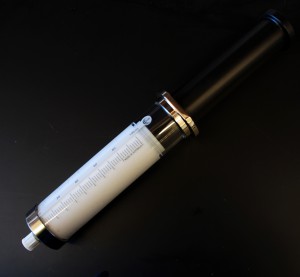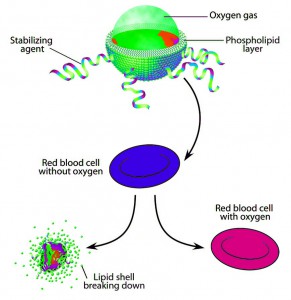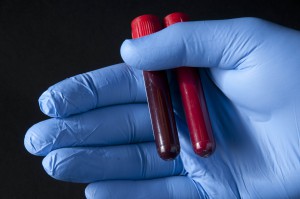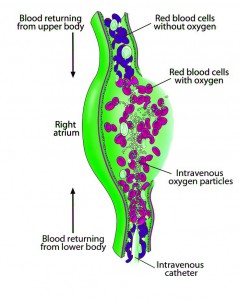
This syringe, containing particles of oxygen gas mixed with liquid, can potentially save the lives of patients unable to breathe -- like the infant Kheir was unable to save early in his career.
John Kheir, MD, is a staff physician and researcher in the Cardiac Intensive Care Unit at Boston Children’s Hospital. As reported this week in Science Translational Medicine, he led a team that created a method for IV oxygen delivery — tiny particles filled with oxygen gas, mixed with liquid and injected directly into the blood. In an emergency, the injections could potentially buy clinicians time to start life-saving therapies. The technology was reported by The Atlantic, Popular Science, Scientific American, Technology Review and other outlets.
It was an ordinary Saturday night in the ICU at Boston Children’s, in the fall of 2006. One of my patients was a 9-month-old girl who was admitted with pneumonia, and was having trouble breathing. I had gone in to check on her just a few minutes before; although she was not feeling well, she reached out and touched my hand as I examined her. I assured her mother she was in the best possible place for her care.
Five minutes later, the code bell alarmed. Our team rushed into her room to the most horrific sight I have ever seen. She lay limp in bed, lifeless. Her face was covered in blood, which we knew came from her lungs. We rushed into position.
My colleague and I placed a breathing tube, while the nursing team performed CPR and administered all of the proper medications. The tube was in the right place, the medications were getting in, everything was happening right on time… but she remained lifeless.
Her oxygen saturation was too low for her to resuscitate, so we decided to put her on a heart-lung bypass machine. This procedure is technically challenging under any circumstances, but here especially when we were performing CPR. Although we were able to get her onto the machine, and her heart was revived, we learned once again the lesson that ICU clinicians hate: The brain is the most sensitive organ to low oxygen delivery. She was no longer the person she could have become. It had all been taken away from her in the 20 minutes her brain was deprived of oxygen. She died three days later.
I was devastated and frustrated. We did everything exactly right. I lay in my bed that night staring at the ceiling. She could not have received better care, and yet she still died. What good was our amazing technology if patients are so injured by the time they are effectively supported?
At the time, I was a fellow - early in my career. I didn’t really know the first thing about research, but I knew that this was a big problem that nobody had an answer for. Why couldn’t we just make a form of oxygen that we could inject into an intravenous line? I found that there was a whole field of research focusing on gas-filled microbubbles that people used for ultrasound contrast agents and for targeted therapy. Maybe we could alter that technology to be able to safely inject oxygen gas.

The microparticle used to package oxygen gas, covered by a layer of fatty molecules and stabilizing agents. Upon contact with an oxygen-poor red blood cell, it releases oxygen, which rapidly binds to the cell. The lipid shell is metabolized by the body.
I had an idea, but no concept of how to approach it. I didn’t have a lab, or money, or a mentor. But the first thing I learned is that inspiration is the sine qua non of important research. Then, I was immensely blessed to find a mentor who took on this ragamuffin researcher with a crazy idea. I met with Frank McGowan, MD, the then-Chief of Cardiac Anesthesia at Boston Children’s — a highly accomplished researcher with nothing to gain (and a lot to lose) from me. But he took me in, met with me often, gave me space in his lab, taught me how to do research, how to write grants and papers, and how to test my ideas in a rigorous way… every essential research skill.
Although we had every likelihood of failure, he took a risk on me. And that is the second lesson I learned: that nothing good ever happens without taking a risk. True accomplishment is what you accomplish when nobody else believes in what you are doing.
 The first experiment I remember was the simplest one we performed. It was a Friday evening, and my mentor was stuck in the operating room. I met him there with a vial of test suspension that my colleague, Mark Borden, PhD, had sent me. During a break, Dr. McGowan drew my blood, and we mixed it with the microparticles. We watched my blood turn from blue to red — indicating that the microparticles had successfully transferred the oxygen to the blood. That success was followed by hundreds of failures… blood that did not turn red, problems manufacturing the microparticles, and animals who did not survive even brief injections.
The first experiment I remember was the simplest one we performed. It was a Friday evening, and my mentor was stuck in the operating room. I met him there with a vial of test suspension that my colleague, Mark Borden, PhD, had sent me. During a break, Dr. McGowan drew my blood, and we mixed it with the microparticles. We watched my blood turn from blue to red — indicating that the microparticles had successfully transferred the oxygen to the blood. That success was followed by hundreds of failures… blood that did not turn red, problems manufacturing the microparticles, and animals who did not survive even brief injections.
The idea of injecting oxygen into a patient is possibly now less far-fetched than it was six years ago. We have many obstacles to overcome to bring this idea to a patient’s bedside. But even if it never happens, I would rather have tried and failed than to have just turned over in bed that night and said, “that’s too bad… we tried everything.”
Hear more in this podcast.
Editor’s note: Boston Children’s Technology Development Fund has invested in the development of the injectable oxygen microparticles. For more information, or to learn about partnership opportunities related to this technology, please contact the Technology and Innovation Development Office by email or phone at (617) 919-3019.








